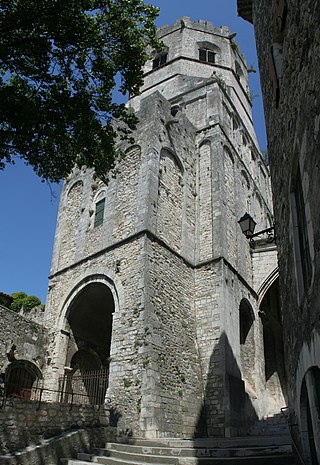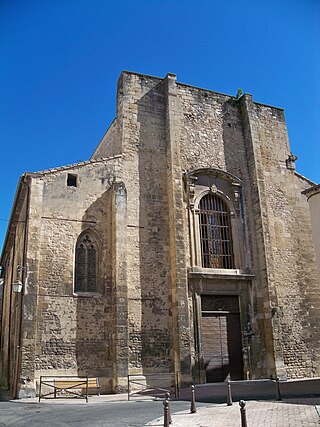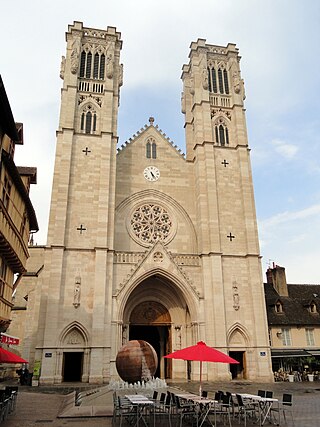
The Archdiocese of Bordeaux (–Bazas) is a Latin Church ecclesiastical territory or archdiocese of the Catholic Church in France. The episcopal see is Bordeaux, Aquitaine. It was established under the Concordat of 1802 by combining the ancient Diocese of Bordeaux with the greater part of the suppressed Diocese of Bazas. The Archdiocese of Bordeaux is a metropolitan see, with four suffragan dioceses in its ecclesiastical province: Dioceses of Agen, Aire and Dax, Bayonne, and Périgueux.

The Catholic Diocese of Fréjus–Toulon is a diocese of the Latin Church of the Catholic Church in southeastern France on the Mediterranean coast. The present diocese comprises the territory of the ancient Diocese of Fréjus as well as that of the ancient Diocese of Toulon. In 1957 it was renamed as the Diocese of Fréjus–Toulon.

The Diocese of Digne is a Latin Church ecclesiastical territory or diocese of the Catholic Church in France. Erected in the 4th century as the Diocese of Digne, the diocese has been known as the Diocese of Digne–Riez–Sisteron since 1922. The diocese comprises the entire department of Alpes-de-Haute-Provence, in the Region of Provence-Alpes-Côte d'Azur. The diocese was a suffragan diocese of the Archdiocese of Aix-en-Provence and Arles until 2002 and is now a suffragan diocese in the ecclesiastical province of the metropolitan Archdiocese of Marseille. The Bishop of Digne's cathedra is found in Digne Cathedral at the episcopal see of Digne-les-Bains.

The Roman Catholic Diocese of Nice is a diocese of the Latin Church of the Roman Catholic Church in France. The diocese comprises the Department of Alpes-Maritimes. The diocese is a suffragan of the Archdiocese of Marseille.

The Diocese of Périgueux and Sarlat is a Latin Church ecclesiastical territory or diocese of the Catholic Church in France. Its episcopal see is Périgueux, in the département of Dordogne, in the région of Aquitaine. The Diocese of Périgueux is a suffragan diocese in the ecclesiastical province of the metropolitan Archdiocese of Bordeaux. The current bishop is Philippe Mousset, who was appointed in 2014.

The Roman Catholic Diocese of Vannes is a diocese of the Latin Church of the Roman Catholic Church in France. Erected in the 5th century, the Episcopal see is Vannes Cathedral in the city of Vannes. The diocese corresponds to the department of Morbihan, and is suffragan to the Archdiocese of Rennes, Dol, and Saint-Malo. Raymond Michel René Centène is the current bishop since his appointment in 2005.

The Diocese of Châlons is a Latin Church ecclesiastical territory or diocese of the Catholic Church in Châlons-sur-Marne, France. The diocese comprises the department of Marne, excluding the arrondissement of Reims.

The Roman Catholic Diocese of Viviers is a diocese of the Latin Church of the Roman Catholic Church in France. Erected in the 4th century, the diocese was restored in the Concordat of 1822, and comprises the department of Ardèche, in the Region of Rhône-Alpes. Currently the diocese is a suffragan of the Archdiocese of Lyon. Its current bishop is Jean-Louis Marie Balsa, appointed in 2015.

The former French Roman Catholic diocese of Agde existed from about the 6th century to the Concordat of 1801 between First Consul Napoleon Bonaparte and Pope Pius VII. Agde is in the south of France, in what is now the department of Hérault. The last bishop, Charles François de Rouvroy de Saint Simon Sandricourt, was guillotined in Paris on July 25, 1794.

The former French Catholic diocese of Riez existed at least from fifth century Gaul to the French Revolution. Its see was at Riez, in the modern department of Alpes-de-Haute-Provence.

The former French Roman Catholic Diocese of Saint-Paul-Trois-Châteaux, sometimes, just like the town, also known as the Diocese of Saint-Paul-en-Tricastin, existed from the sixth century to the French Revolution.

The former French diocese of Cavaillon existed until the French Revolution as a diocese of the Comtat Venaissin, a fief of the Church of Rome. It was a member of the ecclesiastical province headed by the Metropolitan Archbishop of Avignon. Its seat was at Cavaillon, in the south-eastern part of what is now France, in the modern department of Vaucluse.

The Diocese of Bazas, centred on Bazas in Aquitaine, covered the Bazadais region, known under the Romans as the Vasatensis pagus after the ancient occupants, the Vasates. In the 2nd century it was part of the Novempopulania, one of the seventeen provinces of Gaul. The diocese must have been created between the first and the third centuries, but because of the large numbers of invaders that passed through this region - Arians, Saracens, Normans - the list of bishops is much reduced during the first millennium. The first bishop of this diocese is mentioned, without a name, by Gregory of Tours in his De gloria martyrum.

The Diocese of Dax or Acqs was a Roman Catholic ecclesiastical territory in Gascony in south-west France. According to tradition it was established in the 5th century. It was suppressed after the French Revolution, by the Concordat of 1801 between First Consul Napoleon Bonaparte and Pope Pius VII. Its territory now belongs to the Diocese of Aire and Diocese of Bayonne.

The Roman Catholic Diocese of Nevers is a diocese of the Latin Church of the Roman Catholic Church in France. The diocese comprises the department of Nièvre, in the Region of Bourgogne.

The Roman Catholic Diocese of Lescar, in south-western France, was founded in the fifth century, and continued until 1790. It was originally part of the Province of Novempopulania, and Lescar held the seventh place among the cities. Its see was the Cathedral of the Assumption in Lescar, begun in 1120; the crypt of the cathedral was also the mausoleum of the family of Albret in the 16th century.

The former French Catholic diocese of Apt, in southeast France, existed from the fourth century until the French Revolution. By the Concordat of 1801, it was suppressed, and its territory was divided between the diocese of Digne and the diocese of Avignon. Its seat was at Apt Cathedral, in Vaucluse.

The ancient residential diocese of Orange in the Comtat Venaissin in Provence, a fief belonging to the papacy, was suppressed by the French government during the French Revolution. It was revived in 2009 as a titular see of the Catholic Church.

The former French Catholic diocese of Grasse was founded in the 4th or 5th century as the diocese of Antibes. It was originally suffragan to the Archbishop of Aix, and then to the Archbishop of Embrun. The see moved from Antibes to Grasse in 1244. It remained at Grasse Cathedral until the French Revolution. The diocese was suppressed by the Concordat of 1801, its territory passing to the diocese of Nice.

The former French Catholic diocese of Chalon-sur-Saône existed until the French Revolution. After the Concordat of 1801, it was suppressed, and its territory went to the diocese of Autun. Its see was Chalon Cathedral.




















